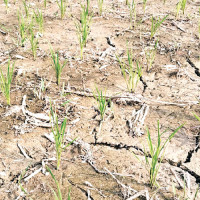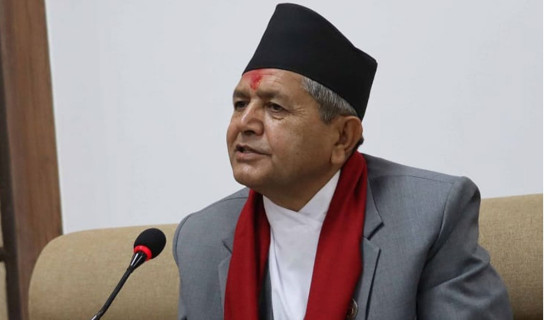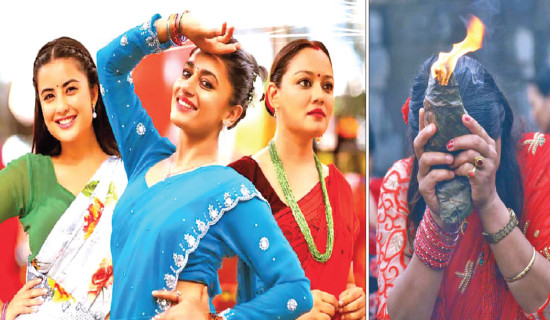- Friday, 22 August 2025
Voluminous Research On Teej Festival
What kind of festival is Teej in Nepal? One remark on behalf of the publisher, Ratna Prasad Shrestha, of this underreviewed 666-page book by Dr Bhupa Hari Poudel is here:The Teej and the Gaura are exclusively women's festivals of Nepal. But in a real sense, these festivals are not limited to this sphere of perception only. They are part of our living heritage.
Here, we have a noted literary scholar who has adopted a comprehensive approach to research with the same perception on Teej themes while writing the voluminous book. There are four Nepali words – Teejko Tarangama Phakriyaka Parampara (Traditions Blossoming in the Ripples of Teej) – for the title of this under-revised book by him.
No doubt, as denoted in this research, the Teej is like an umbrella festival, where traditions and traditions of love, devotion, purity of sentiments, and good wishes have been manifested colourfully. Who does not love such festivals? However, the second Nepali word of the title, 'Taranga', or 'ripple', also indicates behavioural changes in the tradition of Teej celebrations. Being a significant publication, the researcher has discussed such issues in detail.
The author's line of literary works, too, needs to be recalled in this context. Memorably, Dr Bhupa Hari Poudel reaches far and wide, collects piles of information, consults with relevant reference materials, analyses, writes, and makes his best efforts to give readers research-based publications. Poudel's already published voluminous literary works, like the "Aitihasik Makai Parwa" (The Literary Scandal Known as Makai Parwa) and the Nepalko Bidwat Parampara (The Academic Traditions of Nepal), are proof of his academic work mode. Thus, the recently published voluminous book entitled "Teejko Tarangama Phakriyaka Parampara" (Blossoming Traditions in the Ripples of Teej Festival) is also a similar addition to the author's credit.
Seeing the anatomy of the book, we find as many as 25 chapters in it. The first chapter's main title is "Parwatiko Tapasya Ra Haritalika Teejko Brataparampara" (Penance of Goddess Parwati and the tradition of Haritalika Teej fasting). A few other chapters, gradually, are Haritalika Teej Ra Rhishi Panchamiko Shabdakoshiya Parampara (Lexicographical tradition of the Haritalika Teej and Rhishi Panchami festivals) and Haritalika Teej Ra Rhishi Panchamiko Jyotishiya Panchanga Parampara (Tradition of astrological fixation of Calendar for Teej and Rhishi Panchami).
Mentioning titles of all 25 chapters is not possible here. To meet the objective of covering diverse aspects of the colourful festivals of Teej, researcher Dr Poudel has allotted separate chapters to mention themes like the classical and non-classical poems related to Teej and about Teej songs of different geographical regions in the country.
From the viewpoint of knowing the rituals of practising the Teej festival, chapters eight and nine are essential because they guide devotees about the rules of worship to celebrate Teej and Rhishipanchami. The ninth chapter is informative, especially about the end-of-day rituals of the Teej festivals.
However, being a work of cultural values based on research, the book's importance is not limited to the practice of sacred Teej; it is also extensively informative for studying culture. The Nepali Teej observer women have been singing their inner sentiments – sometimes directly and sometimes in a symbolic way – during Teej; it has become a cherished practice. Pages 305-404 of the book describe this aspect.
We can also quote some of the Teej songs and their diverse themes and sentiments from the book:
Hulakama Chithi Chha Radioma Khabara
Malai Samhji Meri Aama rune Nagara
Page 290 in the book
Through these two lines, married women sing their pain, console themselves, and express their deep love for their mother during the Teej festival.
With a theme filled with humour and satire, there is another kind of Geet in the book, which helps to know more about the sentiments of women during Teej:
Napadheki Chhorilai Padhekalai Dinubho
Barilai Babahajur Ma Chhoriko Papai Linubho
Swamijile Pani Mange Angrejima Watara
Barilai Nabujhera Diyen Maile Kancho Katahara
291 in the book
This song reveals the suffocations of married, uneducated daughters. In sharp, humour-satire expressions, the song expresses the grudges of such daughters with their fathers for not sending them to school for education.
Themes are unlimited, and women have been singing their joys, sadness, and stories of their struggle, discrimination, and despairs of life through Teej songs. When the Teej festival arrives once each year, it generates a maniacal effect in the country.
How can a festival make a whole condition joyous? We don't know exactly about other festivals. But concerning the under-reviewed voluminous book "Teejko Tarangama Phakriyaka Parampara", we can say Teej fervours grip the nation's joyous spirit. No doubt, there is a change in Teej celebrations with the change of times, but the rich religious and traditional values are also intact. It means positivity is greatly cherished.
Conclusively, such research works come after years of effort. Dr Bhupa Hari Poudel, who is forever energetic in Nepali literary study, deserves good wishes for writing the book on the popular festival of Teej.
(Kafle is a former deputy executive editor for this daily.)















